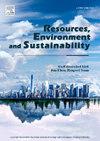How does the long-term return of mix-sowing green manures increase nitrogen utilization and decrease ecological costs of wheatland under reduced chemical nitrogen input?
IF 12.4
Q1 ENVIRONMENTAL SCIENCES
引用次数: 0
Abstract
Increasing nitrogen (N) utilization and reducing ecological costs of farmland are key objectives for mitigating environmental pollution and advancing sustainable agricultural development. Green manure is widely used to increase crop N efficiency while replacing partial chemical N input. However, it remains uncertain whether reducing chemical N supply, combined with mix-sowing green manures, could increase N utilization and reduce ecological costs of wheatland, revealing its mechanisms of soil N regulation and bacteria diversity. A 6-year field experiment was conducted in an arid irrigation area of northwestern China, implementing wheat multi-cropping different green manures and mix-sowing green manures (F, fallow; CV, common vetch; R, rapeseed; HCV, hairy vetch and common vetch) under reduced chemical N (N3, conventional N application rate; N2, reduced N by 20%; N1, reduced N by 40%). Our results showed that reducing chemical N decreased wheat yield and N efficiency, while green manure return increased wheat yield and N efficiency. Under N2, HCV had a higher wheat yield and N efficiency than CV, R, and F. Wheat N uptake and active N loss were decreased with chemical N reduction but enhanced with green manure return. HCVN2 improved wheat N uptake by 8.3% while reducing ammonia volatilization, nitrous oxide emissions, and nitrate leaching by 12.5%, 17.2%, and 22.1%, respectively, compared to FN3. The mechanisms of HCVN2 enhanced N utilization and reduced ecological costs of wheatland, mainly including increased N contents in the 0–40 cm soil layer, improved soil enzyme activities of N metabolism, and enriched soil bacterial diversity. Therefore, mix-sowing green manures return enhanced N utilization and decreased ecological costs of wheatland under a 20% reduction in chemical N input.

在化学氮投入减少的情况下,混播绿肥的长期回报是如何提高小麦地氮素利用率和降低生态成本的?
提高农田氮素利用率,降低农田生态成本,是缓解环境污染、促进农业可持续发展的关键目标。绿肥被广泛用于提高作物氮效率,同时替代部分化学氮输入。然而,减少化学施氮与混播绿肥是否能提高小麦地氮素利用率,降低生态成本,揭示其对土壤氮素调控和细菌多样性的机制尚不明确。在西北干旱灌区进行了为期6年的大田试验,采用小麦复种不同绿肥和混播绿肥(F、休耕;CV,普通紫薇;R,油菜籽;还原性化学N (N3,常规施氮量)条件下HCV、毛叶黄鼠和普通叶黄鼠;N2,使N降低20%;N1, N降低40%)。结果表明,化学施氮降低了小麦产量和氮素效率,而绿肥还田提高了小麦产量和氮素效率。氮肥处理下,HCV比CV、R和f具有更高的小麦产量和氮素效率,化学降氮降低了小麦氮素吸收和活性氮素损失,绿肥还田提高了氮素吸收和活性氮素损失。与FN3相比,HCVN2使小麦氮素吸收提高了8.3%,同时使氨挥发、一氧化二氮排放和硝酸盐淋溶分别降低了12.5%、17.2%和22.1%。HCVN2提高小麦地氮素利用和降低生态成本的机制主要包括提高0 ~ 40 cm土层氮素含量、提高土壤氮素代谢酶活性和丰富土壤细菌多样性。因此,在化学施氮量减少20%的情况下,混播绿肥能提高小麦地氮素利用率,降低生态成本。
本文章由计算机程序翻译,如有差异,请以英文原文为准。
求助全文
约1分钟内获得全文
求助全文
来源期刊

Resources Environment and Sustainability
Environmental Science-Environmental Science (miscellaneous)
CiteScore
15.10
自引率
0.00%
发文量
41
审稿时长
33 days
 求助内容:
求助内容: 应助结果提醒方式:
应助结果提醒方式:


